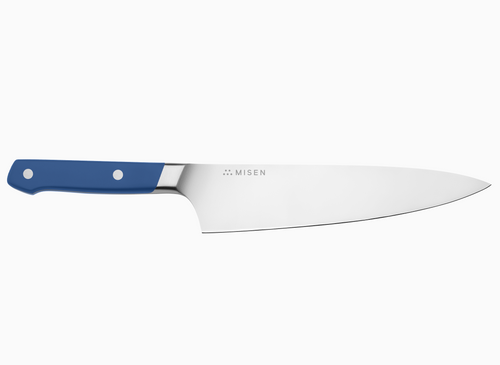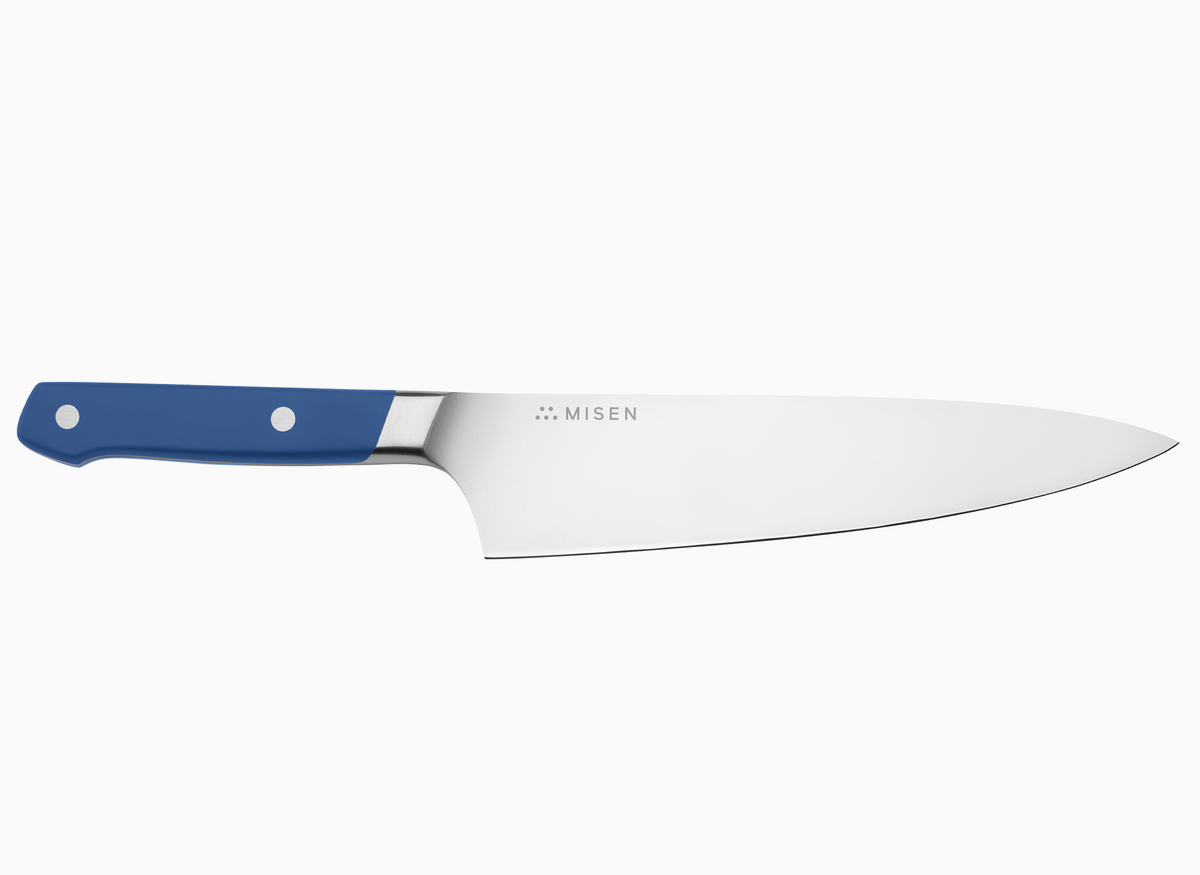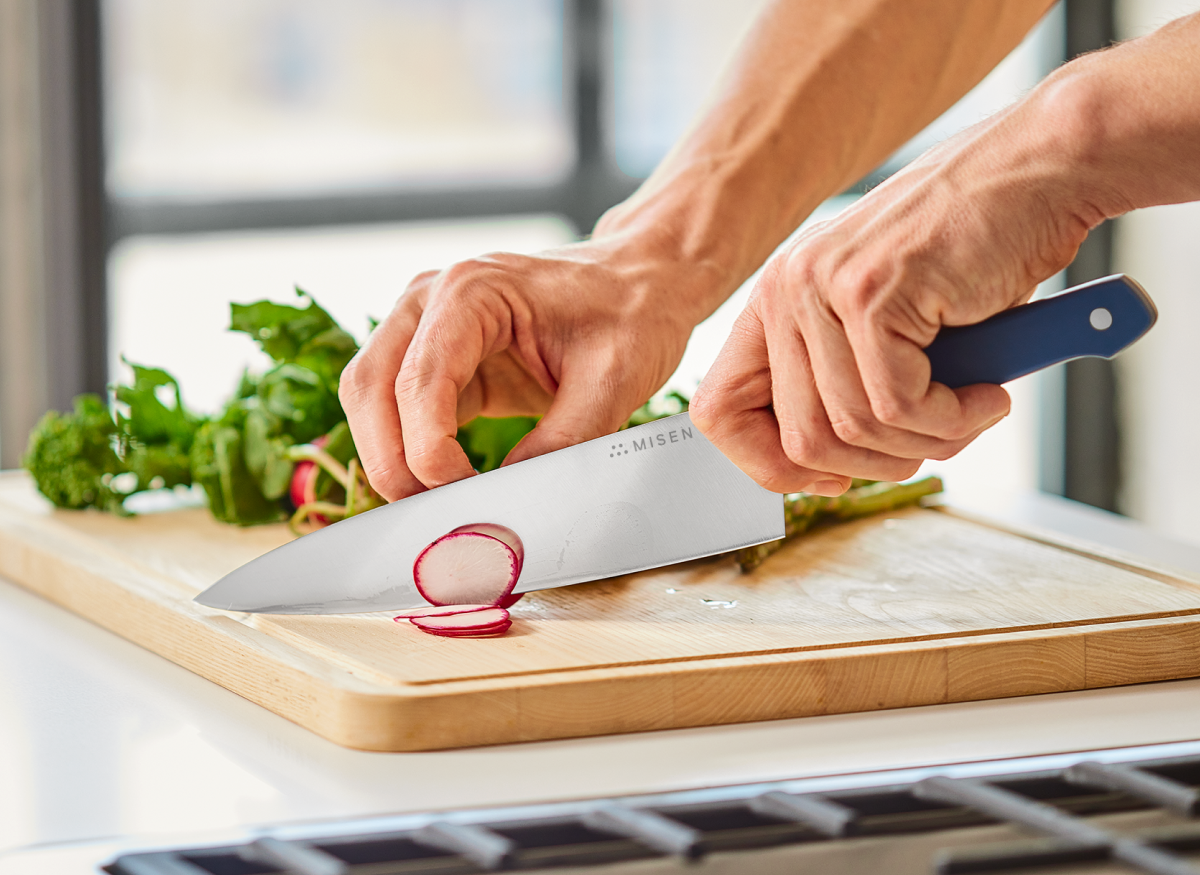Honing vs. Sharpening: Which Do Your Knives Need?
- The edge of your knife blade is made up of microscopic steel teeth.
- When those teeth wear away, it’s time to sharpen your knife.
- Once your knife is sharpened, you can keep it that way with regular honing.
You say tomayto, I say tomahto — but neither one of them can be sliced with a dull knife. That’s why it’s important to know the difference between knife honing vs. sharpening.
Both might seem as if they lead to the same result, which is to improve the sharpness of your knife, but they actually accomplish different things. Below, we’ll tell you the difference and introduce you to all your sharpening and honing options, including the sharpening tool most pro chefs use.
What Makes a Knife Blade Dull?
Wrapping your head around the difference between honing and sharpening starts with understanding why your knife blade has gone dull. For that, you have to shrink yourself down to a microscopic size.
Imagine you’re so small that you can walk along the edge of your favorite kitchen knife. What you’d see resembles the edge of a serrated bread knife. Let’s say it’s your chef’s knife. The edge of the blade is made up of microscopic steel teeth. They’re not as obvious as the teeth on a serrated knife, but they’re there.
Your chef’s knife works because all those teeth are present, aligned, and pointed downward, but regular use (and regular whacking against your cutting board) bends those teeth and pushes them out of alignment. The result? You can’t even slice a tomato.
It doesn’t mean your knife can’t give you a serious cut. It’s just not able to tear through the smooth surface of a tomato skin. Who knew tomatoes had such power?
Honing vs. Sharpening
Okay, now bounce out of your microscopic mode and bring yourself back to a regular size. Take a look at that knife. You can’t see those bent and misaligned teeth, but you know you have a problem to fix.
Here’s the quandary. Do you have to sharpen the knife to give it new teeth, or do you just have to get all those bent and misaligned teeth standing upright again? That’s the difference between honing and sharpening.
A knife has to start with a sharp edge, then to maintain and lengthen the time it stays sharp, the knife has to be honed. Honing is regular maintenance that extends the knife’s sharp edge. Make it sharp and then keep it that way with honing.
Sharpen First
“No more teeth.” That’s how best-selling cookbook author and TV personality Jacques Pépin describes a knife that needs sharpening.
A dull knife is often obvious. Other than the tomato frustration we’ve already talked about, you’ll notice that you’re pushing or using more force to cut and chop. That’s dangerous because it creates more opportunities for accidents. A dull knife also cuts food unevenly, causing cooking problems.
If you’re trying to decide whether your knife needs to be sharpened, an onion can tell you. A sufficiently sharp knife will cut cleanly through the onion. If your knife is dull, you’ll damage the onion’s cell structure as you attempt to cut it. This will release a chemical called lachrymatory factor, or LF, that makes you cry.
You’ve activated the onion’s self-defense mechanism, and it’s because your dull knife ruptured the onion’s cell structures rather than slicing cleanly through them.
Those microscopic teeth aren’t just out of alignment. They’re missing. Your knife has “no more teeth.” The only way to get those teeth back is to reshape the edge of your knife by sharpening.
Here’s the thing to understand about sharpening your knives: each time, you are removing a small amount of a knife’s steel edge. That’s why it’s crucial to know the difference between sharpening and honing, and only sharpen your knives when necessary.
Options for Sharpening Your Knife
 A 220-grit sharpening stone
A 220-grit sharpening stone
The easiest way to sharpen your knives is to send them out to a professional sharpening service. Misen offers Mail-In Knife Sharpening starting at $11/knife.
If you’d prefer to do it yourself, you can purchase an electric knife sharpener. These sharpeners have abrasives on motorized wheels that spin against the knife blade and remove steel to re-establish an edge.
Electric knife sharpeners take away the guesswork about knife edge angles and can even convert a standard 20-degree knife into a sharper 15-degree blade. (Of course, if you’re looking to buy a super sharp knife, all Misen knives are already designed with that sharper 15-degree angle.)
If you purchase a manual knife sharpener, you’ll spend less money but do more of the work. Manual knife sharpeners work the same way as the motorized versions and are usually small enough to store in a kitchen drawer.
Of course, we saved the best and most challenging for last: You can also use a whetstone, like this professional quality whetstone. Serious chefs who don’t use a sharpening service prefer this method because it removes less steel from the blade.
Sharpening with a whetstone, sometimes called a sharpening stone, does take practice. Correctly sharpening your knives this way requires that you maintain the proper angle. Make it easy by attaching a quarter-inch binder clip over the spine of the knife. You’ll have a constant angle of 22 degrees.
Once you’ve successfully sharpened your knives, you can test them again. There should be minimal crying when you cut an onion.
Maintain Sharpness With Regular Honing
Once your knife is sharp, it’s time to get into a regular cycle of honing. New York City Institute of Culinary Education’s knife skills instructor Norman Weinstein observes that the knife sharpening steel has an unfortunate name because it isn’t really sharpening your knife. Instead, it’s honing the edge to keep its teeth aligned.
Sharpening your knife gave you a fresh edge with new teeth. Each time you use it afterwards, some of those teeth will be bent or misaligned. Regular honing returns the teeth to their optimal position. Hone your workhorse knives – like your chef’s knife or paring knife – prior to each use. It’s an easy and quick process that will only add a minute to your food prep.
You’ll need a honing steel, also known as a knife sharpening steel. If you purchased a knife set, it may have come with a metal rod — that’s your honing steel. These rods can vary in length. Use one that’s several inches longer than the longest knife you plan to hone. Keep your sharpening steel handy so you’ll be more likely to use it regularly.
There are three main things to remember about knife honing.
- Find the right angle.
- Don’t press too hard.
- Don’t overdo it.
Of these three things, it’s the angle that will require most of your attention. German-style knives like Zwilling J.A. Henckels, Wüsthof, or Sabatier have edge angles of 20–22 degrees on both sides of the blade’s edge. Japanese-style knives have more acute angles of 11–15 degrees.
Your goal is to match that angle when you hone. And the more you hone, the easier it becomes to hold the blade at the correct angle for your style of knife.
Choosing a Sharpening Steel
Not all sharpening steels are made of steel. Some are coated with diamond dust and others are made from ceramic. Diamond dust is harder and more aggressive than steel, so it’s going to act more like a sharpener. We don’t recommend it for the regular realignment of your knife’s teeth. Ceramic rods, on the other hand, are less aggressive than diamond and can sharpen as well or better than a steel.
Once you’ve chosen your sharpening steel, you’ll need to take care of it. You clean a knife each time you use it, and you should also clean your sharpening steel every time you hone your knife. Wipe it down with a cloth to dislodge and remove the fine steel particles that can rub off on the sharpening steel during honing.
What Happens If You Don’t Sharpen and Hone Your Knives?
 A sharp knife easily slices through slippery fruit.
A sharp knife easily slices through slippery fruit.
There’s what happens to your knives, and then there’s what happens to your food. A sharp knife is an efficient tool that’s actually safer than a dull knife. Sharp knives also help to prevent food from rapid oxidation because the clean slice ruptures fewer cells, exposing less surface area. Remember the onion?
Bon Appetit advises that never sharpening your knives is like never putting air in your tires. Sooner or later, you’re not going to get anywhere.
Knives are a big part of your cooking experience. Learning how to keep them sharp will make all of your prep work easier.








